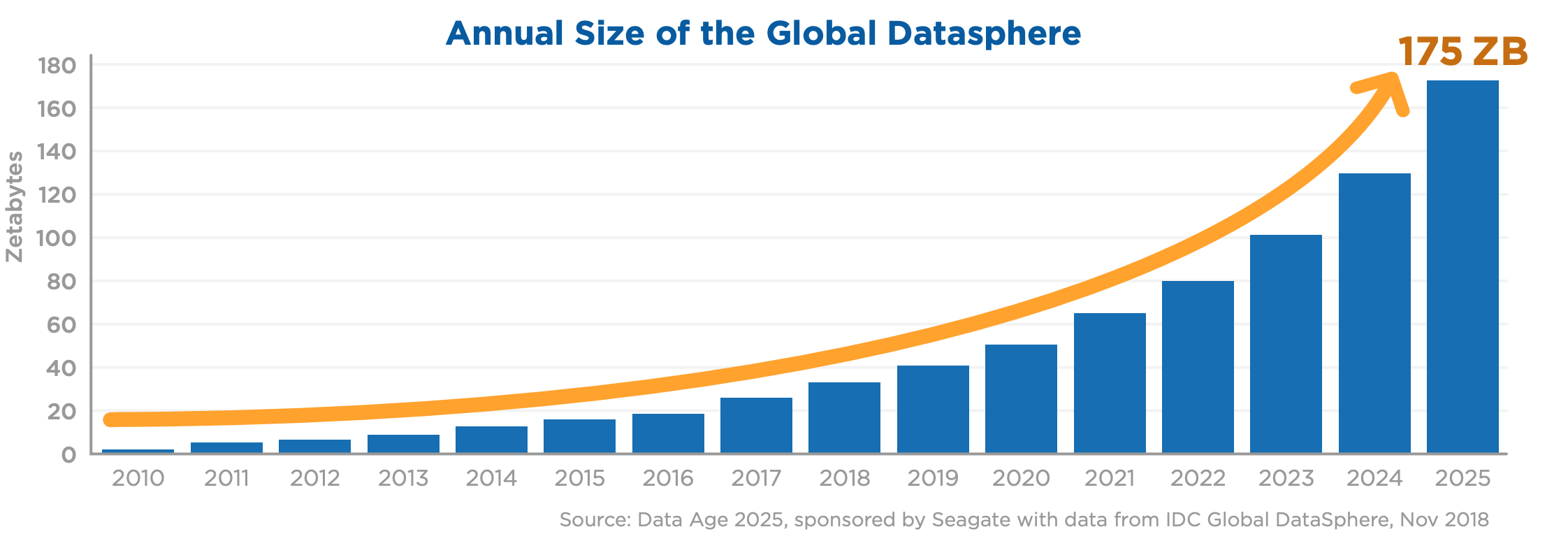
Ever wondered how much data exists in our lives? You’re not alone. It seems we use something that stores or creates data on a daily basis. These days, something as simple as a smart TV, or sending out a tweet can generate data. Statista estimates there are roughly 22.6 billion devices connected to the internet in 2019. These devices (fitness trackers, smart refrigerators, smart thermostats, etc.) all contribute to the amount of data that is produced in the world today.

Digital Information
According to the International Data Corporation, 18 Zettabytes were recorded on the ‘Global Datasphere’ in 2018. The Global Datasphere is a term that quantifies how much data is created, captured, and replicated in the world. To put that into perspective you would need to know that a Zettabyte is equal to a trillion Gigabytes…yes… a trillion. As of 2018, there were 3.7 billion users accessing the internet, a 7.5 percent increase since 2016. That is almost half the world’s population creating digital traffic, and it shows no signs of stopping. In fact, the IDC predicts that by 2025, the Global Datasphere will hold 175 Zettabytes of data.

Hard Copy Information
Even with the digitalization of documents, hard copy production of information for many businesses and consumers still exists, and only adds to the amount of data being produced each year. According to a FoxIt PDF study, when businesses were asked how often they deal with paper, a total of 79% of all respondents indicated that they use paper on a daily, weekly, or monthly basis. Couple that with the fact that on average an office worker uses 10,000 sheets of paper each year, one can begin to understand that physical records show no indications of slowing either.
What is the Significance?
With a record amount of data being produced each year, it is essential to understand the best practices when it comes to protecting data both in physical and digital form. The risk of data being stolen increases greatly if devices or hard copies are not securely protected and stored. A study from Ponemon Institute in 2018 showed that personally identifiable information is being sold online for $158.00 per record and medical files are being sold for more than double at $355.00. Unprotected data can be an extremely valuable target for data thieves. However, there are a few things you can do to mitigate the risk of your information ending up in the wrong hands.
Steps to Mitigate Data Theft
- Always keep computer and phone software up to date.
- Classify data assets.
- Assess existing risks and identify gaps.
- Generate unique passwords and update them regularly.
- Keep personal and work emails separate.
- Schedule backups regularly for all devices.
- Understand and identify the types of breaches that exist.
Protecting Physical Records
When it comes to hard copy documents the security of storing those documents should be the number one priority. Unfortunately, this is where many businesses and individuals get it wrong. Storage units and office closets are common areas that we see physical records being stored and are also places that pose significant security risks to your documents. To properly protect vital documents, a records storage facility is the optimal choice as it provides:
- 24/7 monitored security for motion, heat, fire, smoke detection, and sprinkler water flow
- Seismic construction
- An easy retrieval process
- Simple inventory management
- Cost effectiveness
Data is projected to double in production in the coming decade, so it is important to become aware of how to properly protect it. Chat with us online or call us @ (888) 478-FILE to speak with an expert that will help you and your business properly manage your information throughout its data lifecycle.